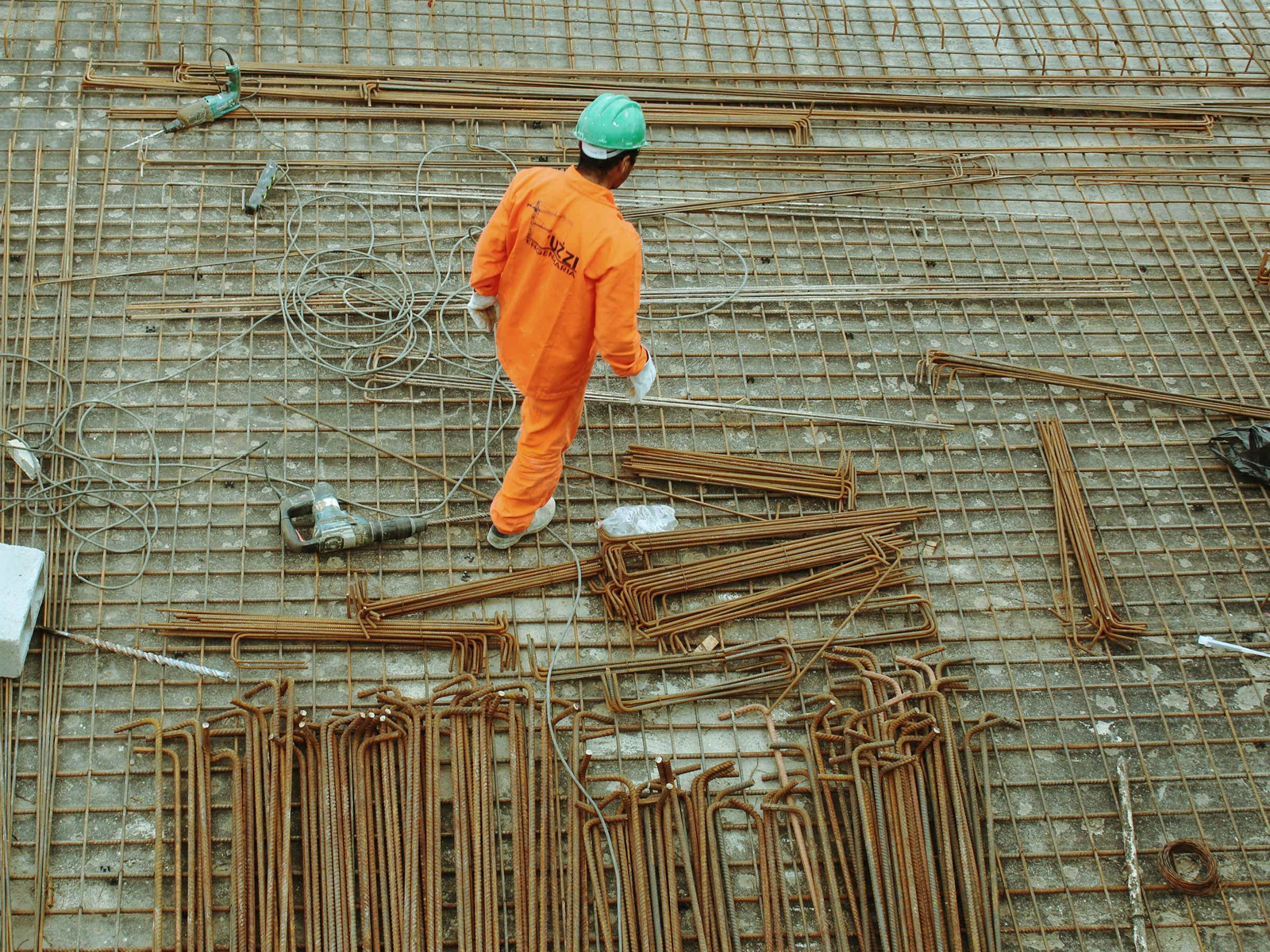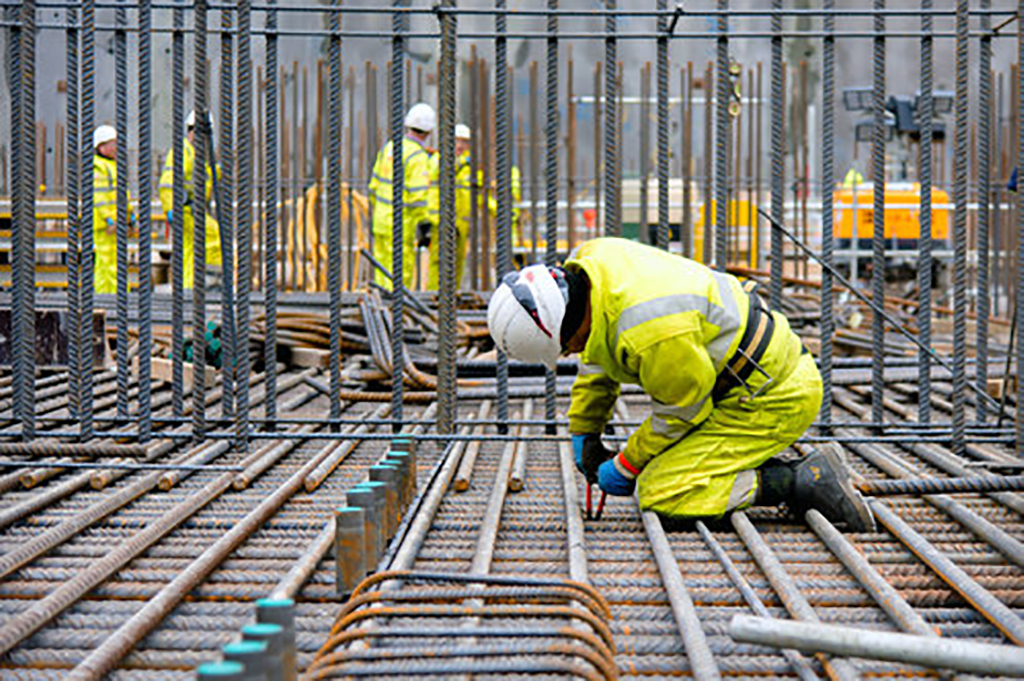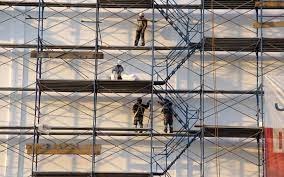Bar Bender and Steel Fixer ( 6 month course)
Bar Bender and Steel Fixer click here
Brief Job Description
Bar bender and Steel Fixer is responsible for efficiently marking, cutting, bending, fabricating, placing and
fixing of reinforcement bars at the desired location using hand/ power tools, within the specified time and
defined tolerance limits, following safe work practices.

Personal Attributes
Bar bender and steel fixers are expected to be physically fit to work across various locations with varied
environmental conditions. The person should be organized, diligent, methodical, safety-conscious, and a
prompt decision-maker. They should have good communication skills along with team spirit.
Read and understand routine drawings / sketches and Bar
Bending Schedule(BBS)
Description
This unit describes the skills and knowledge required to read and understand routine drawings/ sketches
and Bar Bending Schedule(BBS)
Scope
The scope covers the following :
Read and understand routine drawings / sketches
Read and understand Bar Bending Schedule(BBS)
Elements and Performance Criteria
Read and understand routine drawings / sketches
To be competent, the user/individual on the job must be able to:
PC1. interpret basic detail like type, dimension, angle/ position of bend and layout plan from the
sketches / drawings
PC2. interpret fixing/insertion sequence from the drawings
PC3. derive the orientation and position of reinforcement bars from the drawing
PC4. interpret drawing to calculate number of chairs and spacer bars to be used
PC5. find out the size and type of cover block to be used from the drawing
PC6. interpret basic sketches to calculate the required cutting length
PC7. interpret drawing/sketches for calculating scope of work and to plan for cutting, bending and
fabricating of reinforcement bars
Read and understand Bar Bending Schedule
To be competent, the user/individual on the job must be able to:
PC8. read and interpret correct detail from bar bending schedule including type, diameter, shape,
cutting length and number of reinforcement bars
PC9. interpret BBS to calculate the cutting length of reinforcement bars
PC10. interpret the terms used in bar bending schedule
PC11. interpret the BBS to estimate quantity of work.
PC12. interpret details from BBS to efficiently plan for cutting reinforcement bars with minimum
wastage
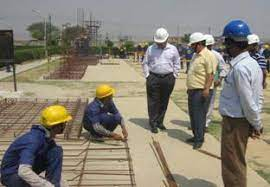
Knowledge and Understanding (KU)
The individual on the job needs to know and understand:
KU1. importance of personal protection including the use of related safety gears & equipment in
accordance with the organizational norms
KU2. service request procedure for tools, materials and equipment as per the organizational
norms
KU3. how to read basic drawing/sketches for bar bending and fixing works
KU4. simple arithmetic calculation
KU5. how to carry out simple measurements using metric and imperial systems
KU6. how to read and understand BBS
KU7. conversion of linear unit for measurement
KU8. unit weight of steel
KU9. different types of cover block and their uses
KU10. different types of steel rods, length and diameter
KU11. different types of binding wire, thickness and uses
KU12. various grades of reinforcement bars
Generic Skills (GS)
User/individual on the job needs to know how to:
GS1. write in at least one language, preferably in the local language of the site
GS2. read drawing/sketches, work and safety-related instructions/signboards in one or more
language,preferably in the local language of the site
GS3. speak in one or more languages, preferably one of the local language at the site
GS4. listen and follow instructions given by the superior
GS5. decide on the safety of workplace and ensure the work does not create hazardous conditions
GS6. plan own work and organize the required resources effectively
GS7. complete work as per agreed time schedule and quality parameters
GS8. resolve any conflict within the teammates
GS9. evaluate the complexity of the tasks and seek assistance and support wherever required
GS10. identify any violation of safety norms during the work and report the same to seniors
Use hand and power tools for cutting and bending of
reinforcement bars
Description
This unit describes the skills and knowledge required for using hand & power tools for cutting and bending
of reinforcement bars
Scope
The scope covers the following :
Use hand and power tools for cutting of reinforcement bars
Use hand and power tools for bending of reinforcement bars
Elements and Performance Criteria
Use hand and power tools for cutting of reinforcement bars
To be competent, the user/individual on the job must be able to:
PC1. select hand /power tools for cutting reinforcement bars as per requirement / instruction
PC2. select cutting blade for cutting machine used for reinforcement bars as per requirement /
instruction
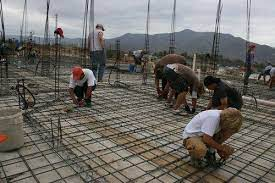
PC3. use measurement and marking tool to mark reinforcement bars for cutting as per specified
length mentioned in Bar Bending Schedule (BBS)
PC4. place reinforcement bars properly for cutting as per requirement and instruction
PC5. ensure the number of reinforcement bars to be cut at any given time is as per the
manufacturer’s guidelines
PC6. maintain correct body posture while cutting reinforcement bars manually or mechanically
PC7. tag and stack reinforcement bars after cutting as per standard practices
Use hand and power tools for bending of reinforcement bars
To be competent, the user/individual on the job must be able to:
PC8. select hand/power tools for bending reinforcement bars as per requirement
PC9. select bar bending accessories as per the diameter of reinforcement bars
PC10. mark, place and fix the reinforcement bars as per the position of bending
PC11. maintain correct body posture while bending rebars manually or mechanically
PC12. bend reinforcement bars as per the shape and dimensions given in the Bar Bending Schedule
(BBS)
PC13. check to ensure that the length and shape of reinforcement bars are as per the Bar Bending
Schedule (BBS) within the tolerance limit
PC14. tag and stack reinforcement bars after bending as per standard practices
PC15. use appropriate personal protective equipment and follow organizational safety guidelines
while cutting and bending of reinforcement bars
Knowledge and Understanding (KU)
The individual on the job needs to know and understand:
KU1. standard practices followed for reinforcement work
KU2. safety rules and regulations for handling and storing required tools, equipment and materials
in accordance with the organizational norms
KU3. use of related safety gears and equipment while cutting and bending reinforcement bars
KU4. organizational service request procedure for tools, materials and equipment
KU5. maintenance of tools and equipment
KU6. simple arithmetic calculation
KU7. conversion of linear unit for measurement
KU8. unit weight and grade of steel
KU9. types of hand tools used for cutting and bending of reinforcement bars
KU10. use of measurement and marking tools for reinforcement bars
KU11. different types of power tools and accessories used for cutting, bending and threading of
reinforcement bars
KU12. how to fix cutting blade and other accessories to the cutting and bending machine
KU13. various types of cutting machines, bending machine and threading machine based on their
capacity
KU14. use of Computer Numerical Control (CNC) machine for reinforcement works
KU15. methods employed for protecting steel from rusting
KU16. tolerance limits for bending and cutting of reinforcement bars
KU17. tagging procedures for reinforcement bars as per their shape, size and location
KU18. standard method of storing cut reinforcement bars and scrap material
KU19. importance of electrical safety of powers tools and equipment used in bar bending works
KU20. safety measures adopted while handling different type of hand and power tools used for
cutting, bending and threading of reinforcement bars
Generic Skills (GS)
User/individual on the job needs to know how to:
GS1. write in at least one language, preferably in the local language of the site
GS2. read drawing/sketches, work and safety-related instructions/signboards in one or more
language, preferably in the local language of the site

GS3. speak in one or more languages, preferably one of the local language at the site
GS4. listen and follow instructions given by the superior
GS5. decide on the safety of workplace and ensure the work does not create hazardous conditions
GS6. plan own work and organize the required resources effectively
GS7. complete work as per agreed time schedule and quality parameters
GS8. resolve any conflict within the teammates
GS9. evaluate the complexity of the tasks and seek assistance and support wherever required
GS10. identify any violation of safety norms during the work and report the same to senior
Prepare, fabricate, place and fix reinforcement bars for RCC
structures
Description
This unit describes the skills and knowledge required to prepare, fabricate, place and fix reinforcement
bars for RCC structures as per Bar Bending Schedule(BBS).
Scope
The scope covers the following :
Fabricate, place and fix reinforcement bars for R.C.C structures as per Bar Bending Schedule(BBS)
and drawing
Elements and Performance Criteria
Fabricate, place and fix reinforcement bars for R.C.C structures as per Bar Bending Schedule(BBS) and
drawing
To be competent, the user/individual on the job must be able to:
PC1. interpret relevant specification given in the sketches/drawing/BBS for fabrication and fixing
of reinforcement bars
PC2. determine correct method of insertion/ fixing of reinforcement bars as per the types of
structure
PC3. select reinforcement bars for placement as per the drawing
PC4. mark, place, and fix the reinforcement bars as per sketch/drawing
PC5. maintain uniform spacing between the bars, stirrups and link rod as per the drawing
PC6. calculate the numbers of couplers for connecting of reinforcement bars as per requirement
PC7. stagger the lap avoiding more than 50% splicing while fabricating the reinforcement cage
PC8. place and fix mechanical coupler as per drawing/BBS
PC9. tie reinforcement bars with approved binding wires as per drawing
PC10. use appropriate personal protective equipment and follow organizational safety guidelines
while fabricating and fixing reinforcement cage
PC11. ensure that the sequence of tying is as per method statement
PC12. fabricate the reinforcement cage and fix it at its position as per the drawing
PC13. place and fix chairs at specified spacing to maintain correct thickness
PC14. ensure cover blocks and spacers are placed to maintain appropriate covers and spacing
PC15. check for the accuracy of location, position and tying of reinforcement bars
PC16. provide suitable stiffeners for lifting in case of prefabricated cage
PC17. check the reinforcement work and verify it as per the drawing
PC18. report the executed work to the superior for quality checks
PC19. take corrective action in case of any error/deviation in work as per instructions
PC20. ensure optimum utilization and minimum wastage of material during the fabrication of
reinforcement cage
Knowledge and Understanding (KU)
The individual on the job needs to know and understand:
KU1. standard practices followed for the fabrication of reinforcement cage
KU2. use of related safety gears & equipment for fabrication of reinforcement cage in accordance
with the organizational norms
KU3. service request procedure for tools, materials and equipment as per the organizational
norms
KU4. basic drawing/sketches related to reinforcement work or R.C.C structure
KU5. different types of reinforcement bars
KU6. different types and thickness of binding wire
KU7. different types of cover blocks available
KU8. basics of concreting works
KU9. basics of shuttering works
KU10. Bar Bending Schedule (BBS) related to reinforcement works
KU11. sequence for tying of reinforcement bars for in-situ and prefabrication works
KU12. insertion and fixing process of reinforcement bars for slab, beam, column, footing, wall,
staircase etc.
KU13. concept of one way and two-way slab
KU14. importance of spacing of reinforcement bars
KU15. prefabrication of reinforcement cage and its uses in different types of structures
KU16. concept of lap length
KU17. importance of lapping of reinforcement bars in its optimum utilization
KU18. different types of stirrups and ties used in bar bending works
KU19. importance of clear cover while carrying out reinforcement works
KU20. use of cover blocks, chairs, spacer bar and hanger bars
KU21. different types of mechanical coupler based of their type, diameter and application
KU22. process of threading of reinforcement bar and its use
KU23. different types of edge protection techniques used for threaded reinforcement bars
KU24. standard tolerance levels in reinforcement work
KU25. importance of optimum utilization and minimum wastage of materials during fabrication of
reinforcement cage
Generic Skills (GS)
User/individual on the job needs to know how to:
GS1. write in at least one language, preferably in the local language of the site
GS2. read drawing/sketches, work and safety-related instructions/signboards in one or more
language, preferably in the local language of the site
GS3. speak in one or more languages, preferably one of the local language at the site
GS4. listen and follow instructions given by the superior
GS5. decide on the safety of workplace and ensure the work does not create hazardous conditions
GS6. decide on correct method for insertion/ fixing of reinforcement bars for any kind of critical
structure or in congested area
GS7. complete work as per agreed time schedule and quality parameters
GS8. resolve any conflict within the teammates
GS9. evaluate the complexity of the tasks and seek assistance and support wherever required
GS10. identify any violation of safety norms during the work and report to senior
GS11. plan own work & organize the required resource effectively
Work effectively in a team to deliver desired results at the
workplace
Description
This unit describes the skills and knowledge required to work effectively within a team to achieve the
desired results
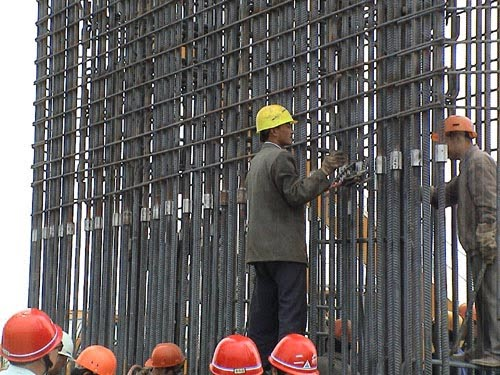
Scope
The scope covers the following :
Interact and communicate in an effective manner
Support co-workers to execute the project requirements
Practice inclusion
Elements and Performance Criteria
Interact and communicate in an effective manner
To be competent, the user/individual on the job must be able to:
PC1. pass on work related information/ requirement clearly to the team members
PC2. inform co-workers and superiors about any kind of deviations from work
PC3. report any unresolved problem to the supervisor immediately
PC4. obtain instructions from superiors and respond on the same
PC5. communicate to team members/subordinates for appropriate work technique and method
PC6. seek clarification and advice as per the requirement
Support co-workers to execute the project requirements
To be competent, the user/individual on the job must be able to:
PC7. hand over the required material, tools, tackles, equipment and work fronts timely to
interfacing teams
PC8. work together with co-workers in a synchronized manner
Practice inclusion
To be competent, the user/individual on the job must be able to:
PC9. maintain cultural inclusivity at work place
PC10. maintain disability friendly work practices
PC11. follow gender neutral practices at workplace
PC12. address discriminatory and offensive behaviour in a professional manner as per
organizational policy
Knowledge and Understanding (KU)
The individual on the job needs to know and understand:
KU1. own roles and responsibilities
KU2. importance of effective communication
KU3. the consequence of poor teamwork on project outcomes, timelines, safety at the
construction site, etc.
KU4. different modes of communication used at workplace
KU5. importance of creating healthy and cooperative work environment among the gangs of
workers
KU6. different activities within the work area where interaction with other workers is required
KU7. applicable techniques of work, properties of materials used, tools and tackles used, safety
standards that co-workers might need as per the requirement
KU8. importance of proper and effective communication and the expected adverse effects in case
of failure relating to quality, timeliness, safety, risks at the construction project site
KU9. importance and need of supporting co-workers facing problems for the smooth functioning of
work
KU10. the fundamental concept of gender equality
KU11. how to recognise and be sensitive to issues of disability, culture and gender
KU12. legislation, policies, and procedures relating to gender sensitivity and cultural diversity
including their impact on the area of operation
Generic Skills (GS)
User/individual on the job needs to know how to:
GS1. write in at least one language, preferably in the local language of the site
GS2. read the communication regarding work completion, materials used, tools and tackles used,
the resource required, etc
,
GS3. speak in one or more languages, preferably in one of the local language of the site
GS4. listen and follow instructions / communication shared by superiors/ co-workers regarding
team requirements or interfaces during work processes
GS5. communicate orally and effectively with co-workers considering their educational and social
background

GS6. decide on what information is to be shared with co-workers within the team or to the
interfacing gang of workers
GS7. plan work and organize the required resources in coordination with team members
GS8. complete all assigned task in coordination with team members
GS9. take initiative in resolving issues among co-workers or report the same to superiors
GS10. ensure best ways of coordination among team members
GS11. evaluate the complexity of task and determine if any guidance is required from superiors
Plan and organize work to meet expected outcomes
Description
This unit describes the knowledge and the skills required for an individual to plan and organize own work in order to meet expected outcome
Scope
The scope covers the following :
Plan and prepare for work
Organise required resources as per work plan
Complete work as per the plan
Elements and Performance Criteria
Plan and prepare for work
To be competent, the user/individual on the job must be able to:
PC1. identify the targets and timelines set by superiors
PC2. determine the work requirements corresponding to
task(drawings/schedules/instructions/methodology), safety, tools and equipment prior to
commencement of task
PC3. plan the work by analyzing the required outcomes, work procedures, allotted time, resource
availability and known priorities
PC4. prepare the work areas in coordination with team members
PC5. plan for waste collection and disposal prior to and after completion of work
Organise required resources as per work plan
To be competent, the user/individual on the job must be able to:
PC6. arrange the required manpower prior to commencement of work
PC7. organize the required materials, tools and tackles required for the task
Complete work as per the plan
To be competent, the user/individual on the job must be able to:
PC8. engage allocated manpower in an appropriate manner
PC9. employ correct tools, tackles and equipment for the desired work
PC10. provide guidance to the subordinates to obtain desired outcome
PC11. use resources in an optimum manner to avoid any unnecessary wastage
PC12. use tools, tackles and equipment carefully to avoid damage
PC13. ensure the work processes adopted are in line with the specified standards and instructions
PC14. complete the work with the allocated resources within specified time
PC15. clean and organize the workplace after completion of task
Knowledge and Understanding (KU)
The individual on the job needs to know and understand:
KU1. importance of proper housekeeping including safe waste disposal
KU2. policies, procedures and work targets set by superiors
KU3. how to identify work activities that need to be planned and organized
KU4. how to determine the task requirements
KU5. how to determine the quality requirements related to the task
KU6. how to undertake all aspect of planning and organizing the task, including interpretation of
task, reading drawing/schedules, arranging resources, reporting problems etc.
KU7. how to implement the planned activities
KU8. how to use available resources in a judicious and appropriate manner to minimize wastages or
damage
Generic Skills (GS)
User/individual on the job needs to know how to:
GS1. write in one or more language, preferably the local language at the site
GS2. read communication from co-workers, superiors and notices from other departments as per
requirement of the level
GS3. speak in one or more language, preferably one of the local language at the site
GS4. follow communication shared by co-workers regarding standard work processes, resources
available, timelines, etc.
GS5. communicate effectively with co-workers and subordinates
GS6. decide on what sequence is to be adopted for execution of work
GS7. plan and organize the materials, tools, tackles and equipment required to execute the work
GS8. complete all assigned task with proper planning and organizing
GS9. analyze areas of work which could result in a delay of work, wastage of material or damage
to tools and tackles
GS10. evaluate potential solutions to minimize avoidable delays and wastages at the construction
site
Work according to personal health, safety and environment
protocols at construction site
Description
This NOS covers the skill and knowledge required for an individual to work according to personal health,
safety and environmental protocols at construction site
Scope
The scope covers the following :
Follow safety norms as defined by organization
Adopt healthy & safe work practices
Implement good housekeeping and environment protection process and activities
Follow infection control guidelines as per applicability
Elements and Performance Criteria
Follow safety norms as defined by the organization
To be competent, the user/individual on the job must be able to:
PC1. identify and report any hazards, risks or breaches in site safety to the appropriate authority
PC2. follow emergency and evacuation procedures in case of accidents, fires, natural calamities
PC3. follow recommended safe practices in handling construction materials, including chemical
and hazardous material whenever applicable
PC4. follow all the protocols and safety techniques conveyed during safety awareness programs
like Tool Box Talks, safety demonstrations and mock drills conducted at the site
PC5. select and operate different types of fire extinguishers corresponding to various types of fires
as per EHS guideline
PC6. identify near miss, unsafe condition and unsafe act
Adopt healthy & safe work practices
To be competent, the user/individual on the job must be able to:
PC7. use appropriate Personal Protective Equipment (PPE) as per work requirements for : Head
Protection, Ear protection, Fall Protection ,Foot Protection, Face and Eye Protection, Hand
and Body Protection , and Respiratory Protection (if required)
PC8. handle all required tools, tackles, materials and equipment safely
PC9. follow safe disposal of waste, harmful and hazardous materials as per EHS guidelines
PC10. check and install all safety equipment as per standard guidelines
PC11. follow safety protocols and practices as laid down by site EHS department
PC12. obtain “height pass” clearance for working at heights
Implement good housekeeping practices
To be competent, the user/individual on the job must be able to:
PC13. collect, segregate and deposit construction waste into appropriate containers based on their
toxicity or hazardous nature
PC14. apply ergonomic principles wherever required
Follow infection control guidelines as per applicability
To be competent, the user/individual on the job must be able to:
PC15. follow recommended personal hygiene, workplace hygiene and sanitization practices
PC16. clean and disinfect all materials, tools and supplies before and after use
PC17. report immediately to concerned authorities regarding signs and symptoms of illness of self
and others
Knowledge and Understanding (KU)
The individual on the job needs to know and understand:
KU1. reporting procedures in cases of breaches or hazards for site safety, accidents, and
emergency situations as per guidelines
KU2. types of safety hazards at construction sites
KU3. basic ergonomic principles as per applicability
KU4. the procedure for responding to accidents and other emergencies at site
KU5. use of appropriate personal protective equipment based on various working conditions
KU6. importance of handling tools, equipment, and materials as per applicable norms
KU7. effect of construction material on health and environments as per applicability
KU8. various environmental protection methods as per applicability
KU9. storage of waste including non-combustible scrap material and debris, combustible scrap
material and debris, general construction waste and trash (non-toxic, non-hazardous), any
other hazardous wastes and any other flammable wastes at the appropriate location
KU10. how to keep the workplace neat and tidy so as to be safe
KU11. how to use hazardous material in a safe and appropriate manner as per applicability
KU12. types of fire
KU13. procedure of operating different types of fire extinguishers
KU14. safety relevant to tools, tackles, and equipment as per applicability
KU15. housekeeping activities relevant to task
KU16. ways of transmission of infection
KU17. ways to manage infectious risks at the workplace
KU18. different methods of cleaning, disinfection, sterilization, and sanitization
KU19. symptoms of infection like fever, cough, redness, swelling, and inflammation
Generic Skills (GS)
User/individual on the job needs to know how to:
GS1. write in at least one language, preferably in the local language of the site
GS2. fill safety formats for near miss, unsafe conditions and safety suggestions
GS3. read in one or more language, preferably in the local language of the site
GS4. speak in one or more language, preferably in one of the local language of the site
GS5. listen to instructions/communication shared by site EHS and superiors regarding site safety,
and conducting the toolbox talk
GS6. identify potential safety risks and report to the appropriate authority
GS7. assess and analyze areas which may affect health, safety and environment protocol on the
site.

